
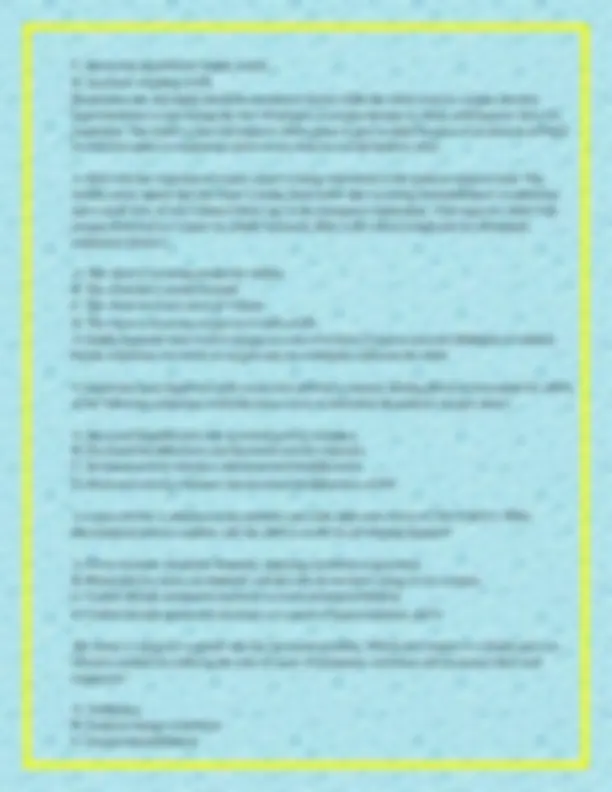
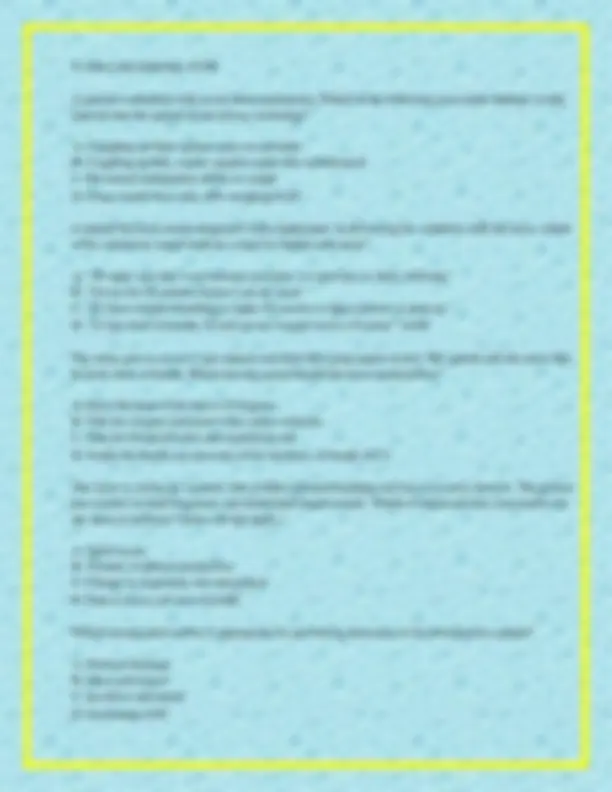
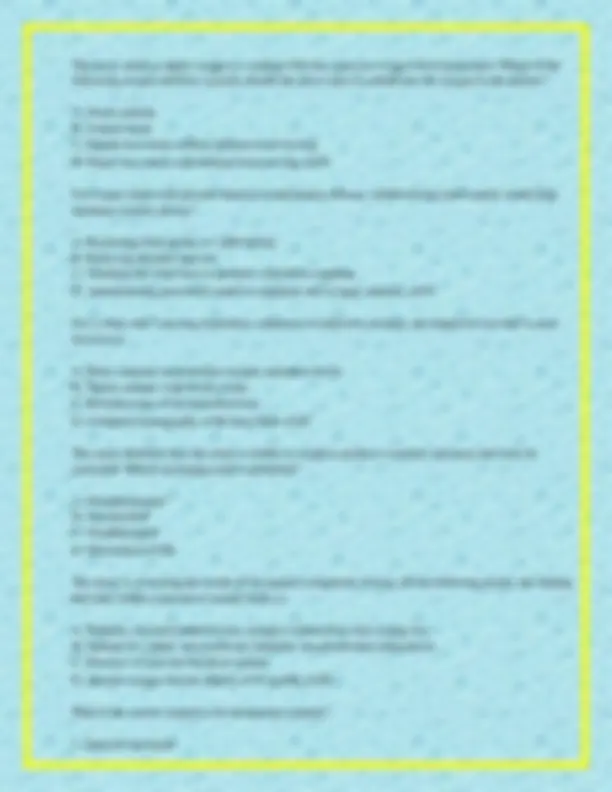
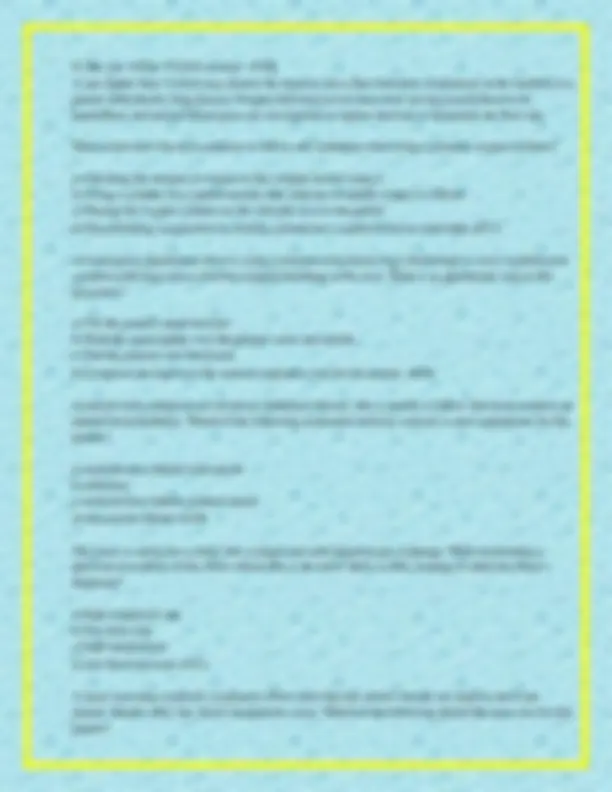
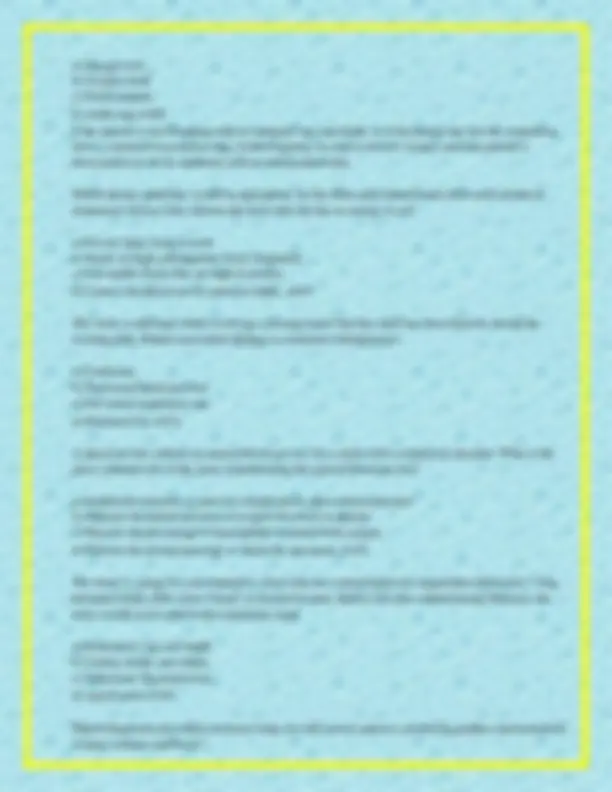
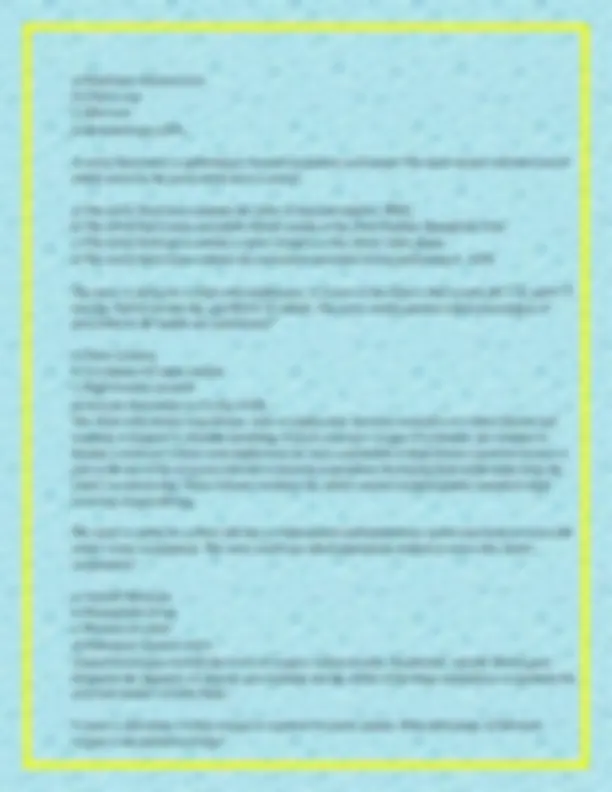
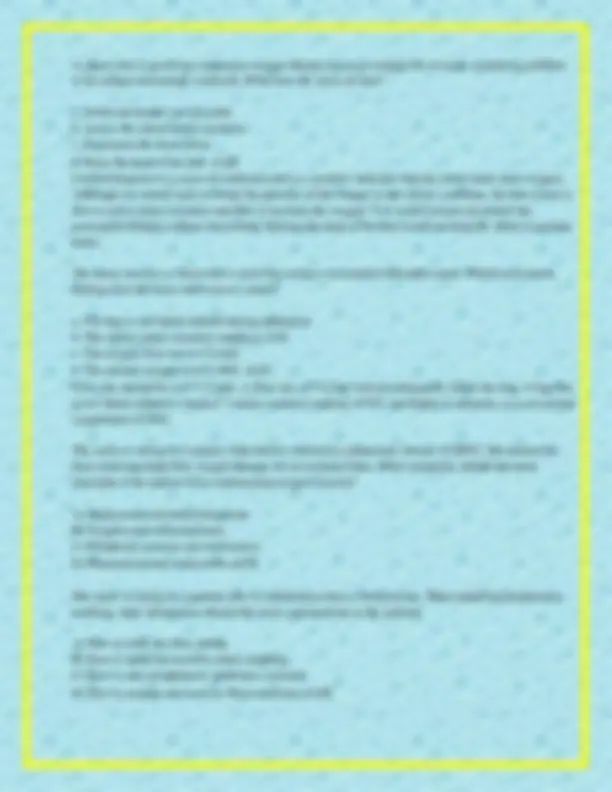
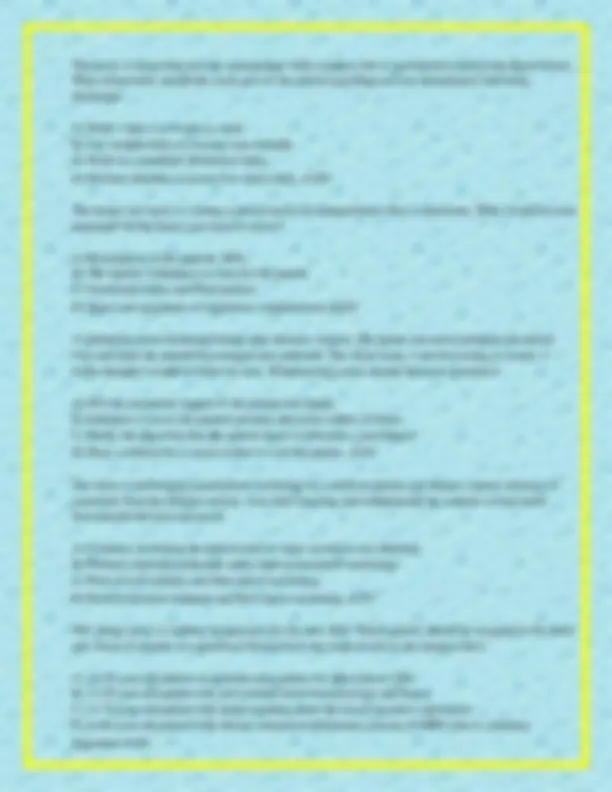
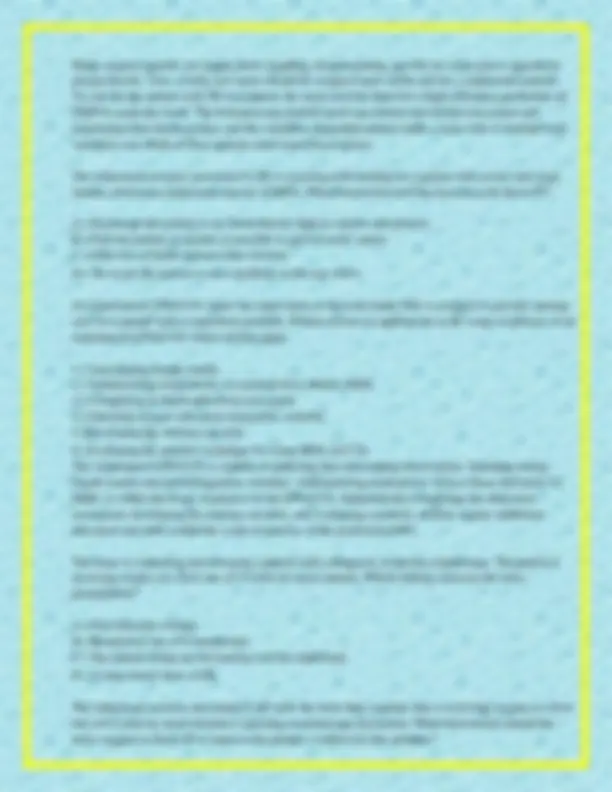
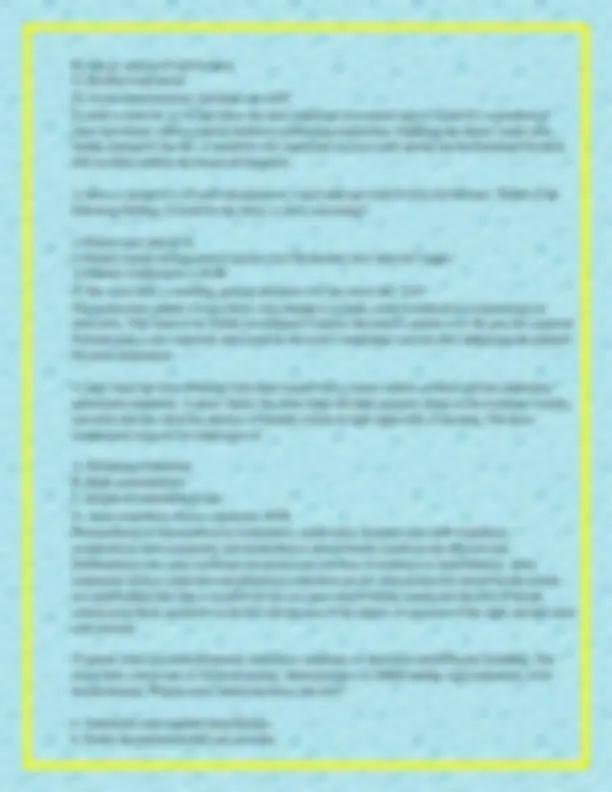
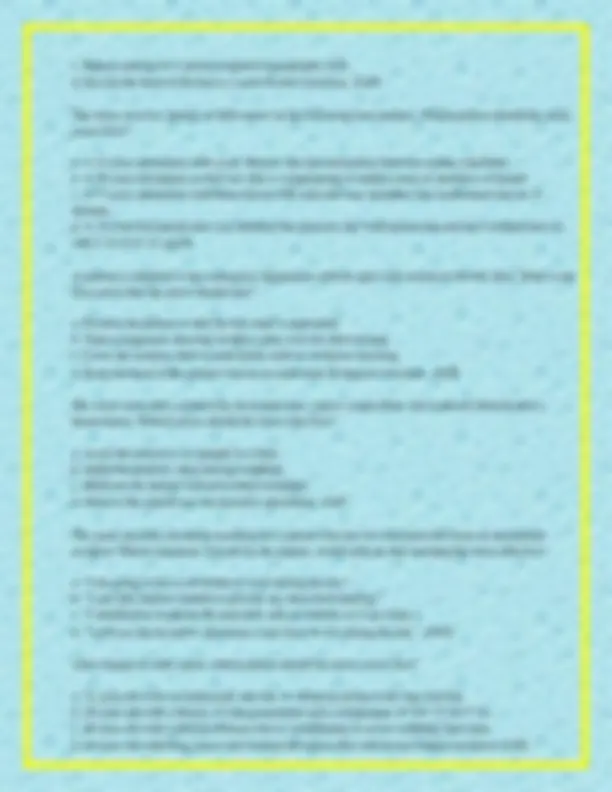
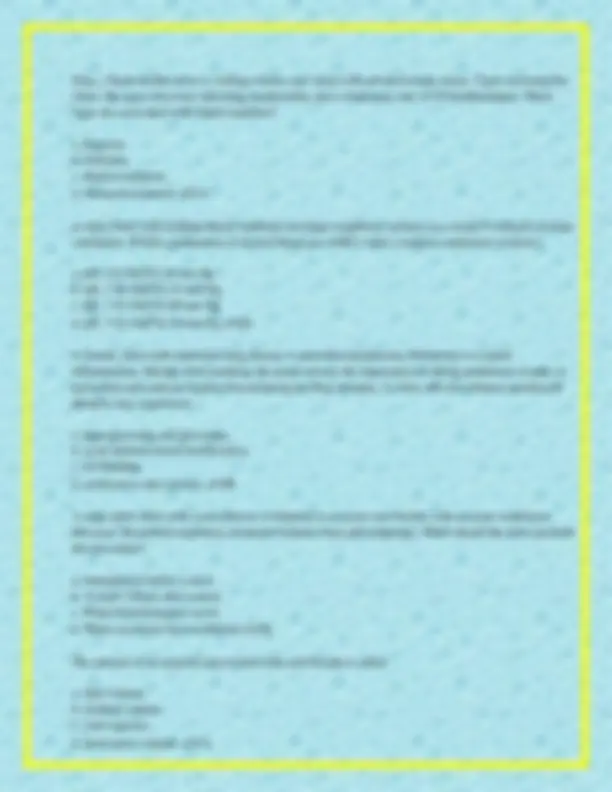
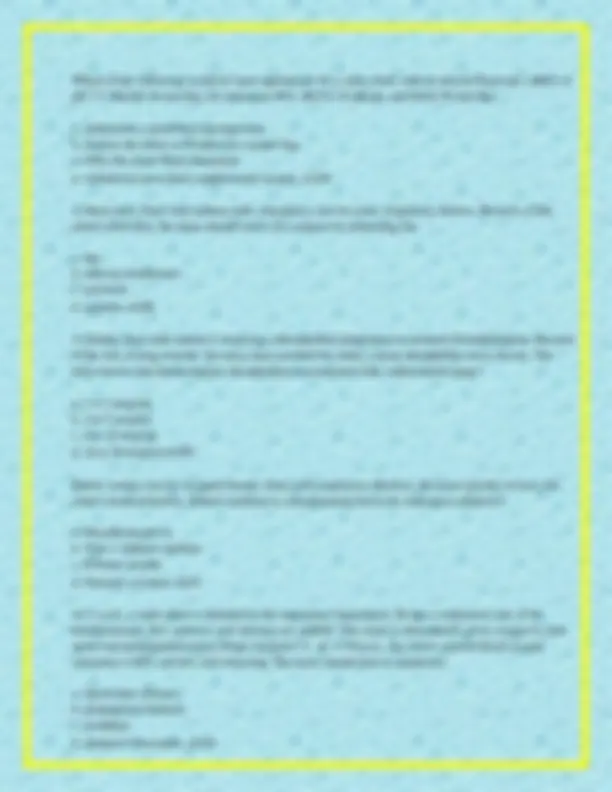
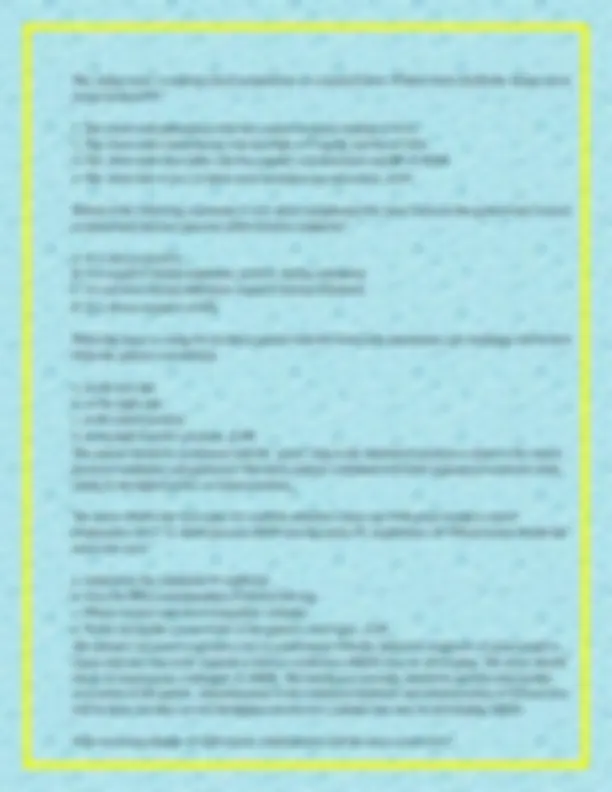
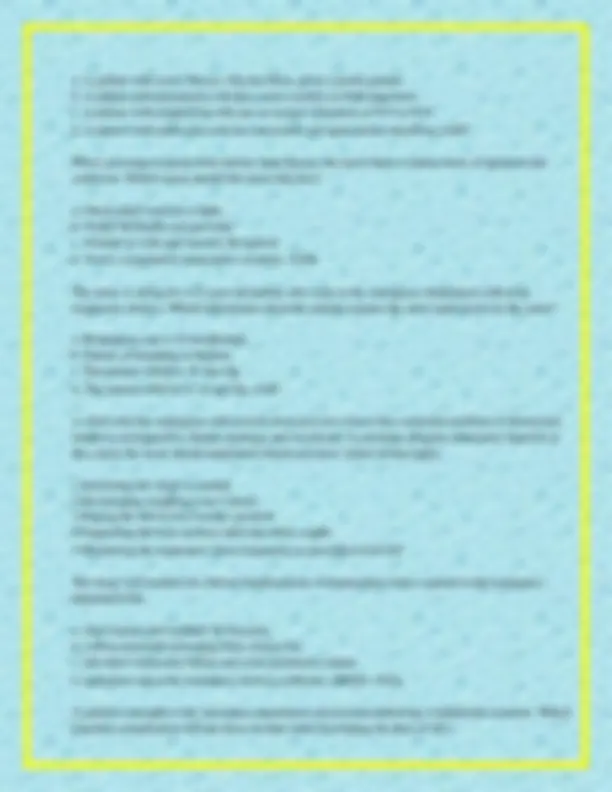
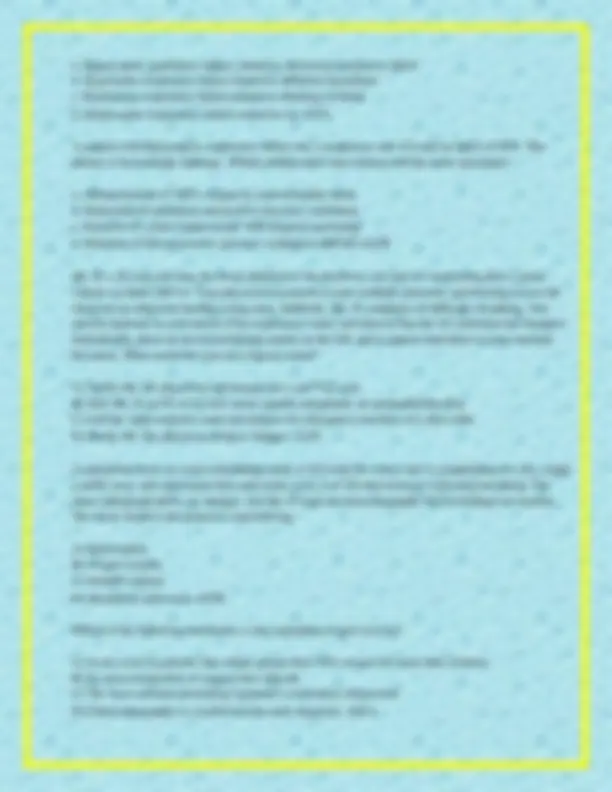
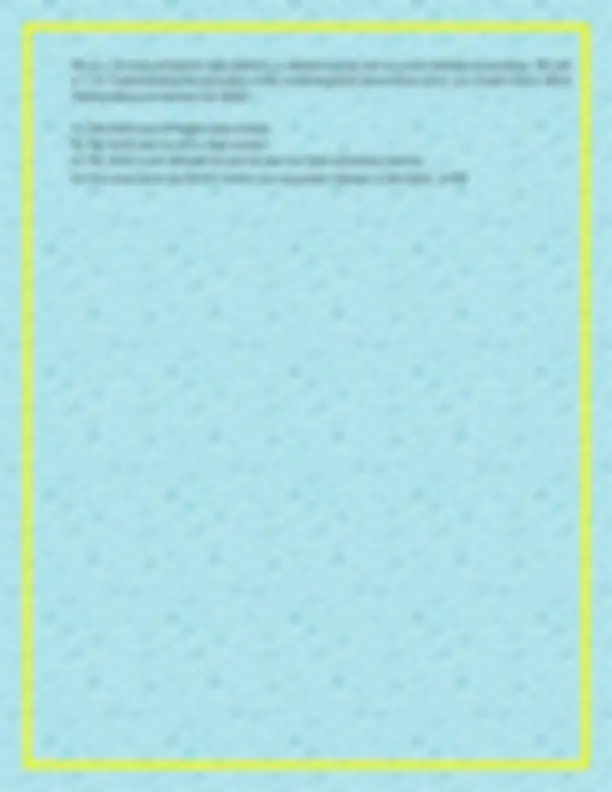


Study with the several resources on Docsity

Earn points by helping other students or get them with a premium plan


Prepare for your exams
Study with the several resources on Docsity

Earn points to download
Earn points by helping other students or get them with a premium plan
Community
Ask the community for help and clear up your study doubts
Discover the best universities in your country according to Docsity users
Free resources
Download our free guides on studying techniques, anxiety management strategies, and thesis advice from Docsity tutors
A series of multiple-choice questions and answers related to oxygenation, a crucial aspect of respiratory care. It covers various scenarios and concepts, including hypoxemia, oxygen delivery devices, and patient management strategies. The questions are designed to test understanding of oxygenation principles and clinical applications, making it a valuable resource for nursing students preparing for the nclex exam.
Typology: Exams
1 / 25

This page cannot be seen from the preview
Don't miss anything!


















An RN from the orthopedic unit has been floated to the medical unit. Which client assignment for the floated RN is best? A. The client with a resolving pulmonary embolus who is receiving oxygen at 6 L/min through a nasal cannula B. The client with chronic lung disease who is being evaluated for possible home oxygen use C. The client with a newly placed tracheostomy who is receiving oxygen through a tracheostomy collar D. The client with chronic bronchitis who is receiving oxygen at 60% through a Venturi mask ✔✔A Orthopedic nurses are familiar with pulmonary emboli and with administration of oxygen through nasal cannulas. Which value indicates clinical hypoxemia and the need to increase oxygen delivery? A. Hemoglobin of 22 g/dL B. PaCO2 of 30 mm Hg C. PaO2 of 65 mm Hg D. Oxygen saturation of 88% ✔✔C PaO2 of 65 mm Hg indicates low levels of oxygen in the arterial blood; this is termed hypoxemia. A client with COPD has a physician's prescription stating, "Adjust oxygen to SpO2 at 90% to 92%." Which nursing action can be delegated to a nursing assistant working under the supervision of an RN? A. Adjust the position of the oxygen tubing B. Assess for signs and symptoms of hypoventilation C. Change the O2 flow rate to keep SpO2 as prescribed D. Choose which O2 delivery device should be used for the client ✔✔A The scope of a nursing assistant's work includes positioning of oxygen tubing for client comfort. A client who smokes is being discharged home on oxygen. The client states, "My lungs are already damaged, so I'm not going to quit smoking." What is the discharge nurse's best response? A. "You can quit when you are ready." B. "It's never too late to quit." C. "Just turn off your oxygen when you smoke." D. "You are right, the damage has been done. But let's talk about why smoking around oxygen is dangerous." ✔✔D This is a great opening for the nurse to educate the client about the dangers of smoking in the presence of oxygen, as well as the benefits of quitting. Which client has the most urgent need for frequent nursing assessment?
A. An older client who was admitted 2 hours ago with emphysema and dyspnea and has a 45-year 2- pack-per-day smoking history, and is receiving 50% oxygen through a Venturi mask B. A young client who has had a tracheostomy for 1 week, who is on room air with SpO2 in the upper 90's, who has been receiving antibiotic therapy for 16 hours, and who has foul-smelling drainage on the tracheostomy ties C. An older adult client who is anxious to go home with her new tank of oxygen and supply of nasal cannulas and is being discharged with a new prescription for home oxygen therapy D. A middle-aged client who was admitted yesterday with pneumonia and is receiving oxygen at 2 L/min through a nasal cannula ✔✔A An older adult client with a long history of smoking and chronic lung disease who is receiving high-flow oxygen delivery is at elevated risk for respiratory depression owing to the hypoxic drive of respirations countered by high levels of oxygen. This client must be assessed frequently while receiving high-flow oxygen. A client has just been admitted to the emergency department and requires high-flow oxygen therapy after suffering facial burns and smoke inhalation. Which oxygen delivery device should the nurse use initially? A. Face tent B. Venturi mask C. Nasal cannula D. Non-rebreather mask ✔✔A A client with smoke inhalation and facial burns who requires high-flow oxygen should initially be placed on a face tent because this is the only noninvasive high-flow device that will minimize painful and contaminating contact with burned facial tissue. A (DNR) client has a non-rebreather oxygen mask and breathing appears to be labored. What does the nurse do first? A. Ensures that the tubing is patent and that oxygen flow is high B. Notifies the chaplain and the family member of record C. Calls the Rapid Response Team and prepares to intubate D. Comforts the client and confirms that signed DNR orders are in the chart ✔✔A Labored breathing and ultimately suffocation can occur if the reservoir bag kinks, or if the oxygen source disconnects or is not set to high flow levels. The client is admitted to the hospital for COPD, and the physician requests a nasal cannula at 2 L/min. Within 30 minutes, the client's color improves. What does the nurse continue to monitor that may require immediate attention? A. Increasing carbon dioxide levels B. Decreasing respiratory rate
D: Chest physiotherapy ✔✔B A patient is admitted with severe lobar pneumonia. Which of the following assessment findings would indicate that the patient needs airway suctioning? A: Coughing up thick sputum only occasionally B: Coughing up thin, watery sputum easily after nebulization C: Decreased independent ability to cough D: Lung sounds clear only after coughing ✔✔C A patient has been newly diagnosed with emphysema. In discussing his condition with the nurse, which of his statements would indicate a need for further education? A: "I'll make sure that I rest between activities so I don't get so short of breath." B: "I'll rest for 30 minutes before I eat my meal." C: "If I have trouble breathing at night, I'll use two to three pillows to prop up." D: "If I get short of breath, I'll turn up my oxygen level to 6 L/min." ✔✔D The nurse goes to assess a new patient and finds him lying supine in bed. The patient tells the nurse that he feels short of breath. Which nursing action should the nurse perform first? A: Raise the head of the bed to 45 degrees. B: Take his oxygen saturation with a pulse oximeter. C: Take his blood pressure and respiratory rate. D: Notify the health care provider of his shortness of breath ✔✔A The nurse is caring for a patient who exhibits labored breathing and uses accessory muscles. The patient has crackles in both lung bases and diminished breath sounds. Which would be priority assessments for the nurse to perform? (Select all that apply.) A: SpO2 levels B: Amount of sputum production C: Change in respiratory rate and pattern D: Pain in lower calf area ✔✔ABC Which nursing intervention is appropriate for preventing atelectasis in the postoperative patient? A: Postural drainage B: Chest percussion C: Incentive spirometer D: Suctioning ✔✔C
The nurse needs to apply oxygen to a patient who has a precise oxygen level prescribed. Which of the following oxygen-delivery systems should the nurse select to administer the oxygen to the patient? A: Nasal cannula B: Venturi mask C: Simple face mask without inflated reservoir bag D: Plastic face mask with inflated reservoir bag ✔✔A For a male client with chronic obstructive pulmonary disease, which nursing intervention would help maintain a patent airway? A. Restricting fluid intake to 1,000 ml/day B. Enforcing absolute bed rest C. Teaching the client how to perform controlled coughing D. Administering prescribed sedatives regularly and in large amounts ✔✔C For a client who is having respiratory symptoms of unknown etiology, the diagnostic test that is most invasive is: A. Pulse oximetry to determine oxygen saturation levels B. Throat cultures with sterile swabs C. Bronchoscopy of the bronchial trees D. Computed tomography of the lung fields ✔✔C The nurse identifies that the client is unable to cough to produce a sputum specimen and must be suctioned. Which suctioning route is preferred? A. Nasopharyngeal B. Nasotracheal C. Oropharyngeal D. Orotracheal ✔✔B The nurse is reviewing the results of the patient's diagnostic testing. Of the following results, the finding that falls within expected or normal limits is: A. Palpable, elevated hardened area around a tuberculosis skin testing site. B. Sputum for culture and sensitivity identifies mycobacterium tuberculosis C. Presence of acid fast bacilli in sputum D. Arterial oxygen tension (PaO2) of 95 mmHg ✔✔D What is the correct sequence for suctioning a patient?
b. Percussion and vibration c. Hyperoxygenation and suctioning d. Administer a bronchodilator and monitor peak flow ✔✔B A nurse is suctioning the nasopharyngeal airway of a patient to maintain a patent airway. For which condition would the nurse anticipate the need for a nasal trumpet? a) The patient vomits during suctioning. b) The secretions appear to be stomach contents. c) The catheter touches an unsterile surface. d) Epistaxis is noted with continued suctioning. ✔✔D A nurse working in a long-term care facility is providing teaching to patients with altered oxygenation due to conditions such as asthma and COPD. Which measures would the nurse recommend? Select all that apply. a) Refrain from exercise. b) Reduce anxiety. c) Eat meals 1 to 2 hours prior to breathing treatments. d) Eat a high-protein/high-calorie diet. e) Maintain a high-Fowler's position when possible. f) Drink 2 to 3 pints of clear fluids daily. ✔✔BDE When caring for patients with COPD, it is important to create an environment that is likely to reduce anxiety and ensure that they eat a high-protein/high-calorie diet. People with dyspnea and orthopnea are most comfortable in a high Fowler's position because accessory muscles can easily be used to promote respiration. Patients with COPD should pace physical activities and schedule frequent rest periods to conserve energy. Meals should be eaten 1 to 2 hours after breathing treatments and exercises, and drinking 2 to 3 quarts (1.9-2.9 L) of clear fluids daily is recommended. A nurse is providing postural drainage for a patient with cystic fibrosis. In which position should the nurse place the patient to drain the right lobe of the lung? a) High Fowler's position b) Left side with pillow under chest wall c) Lying position/half on abdomen and half on side d) Trendelenberg position ✔✔B When planning care for a patient with chronic lung disease who is receiving oxygen through a nasal cannula, what does the nurse expect? a) The oxygen must be humidified. b) The rate will be no more than 2 to 3 L/min or less. c) Arterial blood gases will be drawn every 4 hours to assess flow rate.
d) The rate will be 6 L/min or more. ✔✔B A rate higher than 3 L/min may destroy the hypoxic drive that stimulates respirations in the medulla in a patient with chronic lung disease. Oxygen delivered at low rates does not necessarily have to be humidified, and arterial blood gases are not required at regular intervals to determine the flow rate. What action does the nurse perform to follow safe technique when using a portable oxygen cylinder? a) Checking the amount of oxygen in the cylinder before using it b) Using a cylinder for a patient transfer that indicates available oxygen is 500 psi c) Placing the oxygen cylinder on the stretcher next to the patient d) Discontinuing oxygen flow by turning cylinder key counterclockwise until tight ✔✔A An emergency department nurse is using a manual resuscitation bag (Ambu bag) to assist ventilation in a patient with lung cancer who has stopped breathing on his own. What is an appropriate step in this procedure? a) Tilt the patient's head forward. b) Hold the mask tightly over the patient's nose and mouth. c) Pull the patient's jaw backward. d) Compress the bag twice the normal respiratory rate for the patient. ✔✔B A patient with a diagnosis of advanced Alzheimer disease who is unable to follow directions requires an inhaled bronchodilator. Which of the following medication delivery systems is most appropriate for this patient? a) metered-dose inhaler with spacer b) nebulizer c) metered-dose inhaler without spacer d) dry powder inhaler ✔✔B The nurse is caring for a client who is diagnosed with impaired gas exchange. While performing a physical assessment of the client, which data is the nurse likely to find, keeping in mind the client's diagnosis? a) high respiratory rate b) low pulse rate c) high temperature d) low blood pressure ✔✔A A nurse assessing a patient's respiratory effort notes that the client's breaths are shallow and 8 per minute. Shortly after, the client's respirations cease. Which of the following should the nurse use for this patient?
a) Pulmonary function tests b) Chest x-ray c) Skin tests d) Bronchoscopy ✔✔A A newly hired nurse is performing a focused respiratory assessment. The nurse mentor will intervene if which action by the newly hired nurse is noted? a) The newly hired nurse palpates the point of maximal impulse (PMI). b) The newly hired nurse auscultates breath sounds as the client breathes through the nose. c) The newly hired nurse attaches a pulse oximetry to the client's index finger. d) The newly hired nurse explains the assessment procedure before performing it. ✔✔B The nurse is caring for a client with emphysema. A review of the client's chart reveals pH 7.36, paO2 73 mm Hg, PaCO2 64 mm Hg, and HCO3 35 mEq/L. The nurse would question which prescription, if prescribed by the health care practitioner? a) Pulse oximetry b) 4 L/minute O2 nasal cannula c) High-Fowler's position d) Increase fluid intake to 3 L/day ✔✔B The client with chronic lung disease, such as emphysema, becomes insensitive to carbon dioxide and responds to hypoxia to stimulate breathing. If given excessive oxygen (4 L/minute), the stimulus to breathe is removed. Clients with emphysema are most comfortable in high-Fowler's position because it aids in the use of the accessory muscles to promote respirations. Increasing fluid intake helps keep the client's secretions thin. Pulse oximetry monitors the client's arterial oxyhemoglobin saturation while receiving oxygen therapy. The nurse is caring for a client who has a compromised cardiopulmonary system and needs to assess the client's tissue oxygenation. The nurse would use which appropriate method to assess this client's oxygenation? a) Arterial blood gas b) Hemoglobin levels c) Hematocrit values d) Pulmonary function ✔✔A Arterial blood gases include the levels of oxygen, carbon dioxide, bicarbonate, and pH. Blood gases determine the adequacy of alveolar gas exchange and the ability of the lungs and kidneys to maintain the acid-base balance of body fluids. A nurse is delivering 3 L/min oxygen to a patient via nasal cannula. What percentage of delivered oxygen is the patient receiving?
a) 32% b) 28% c) 47% d) 23% ✔✔A A nasal cannula is used to deliver from 1 L/minute to 6 L/minute of oxygen. 1 L/minute = 24%, 2 L/minute = 28%, 3 L/minute = 32%, 4 L/minute = 36%, 5 L/minute = 40%, and 6 L/minute = 44% What structural changes to the respiratory system should a nurse observe when caring for older adults? a) increased use of accessory muscles for breathing b) respiratory muscles become weaker c) increased mouth breathing and snoring d) diminished coughing and gag reflexes ✔✔B One of the structural changes affecting the respiratory system that a nurse should observe in an older adult is respiratory muscles becoming weaker. The nurse should also observe other structural changes: the chest wall becomes stiffer as a result of calcification of the intercostals cartilage, kyphoscoliosis, and arthritic changes to costovertebral joints; the ribs and vertebrae lose calcium; the lungs become smaller and less elastic; alveoli enlarge; and alveolar walls become thinner. Diminished coughing and gag reflexes, increased use of accessory muscles for breathing, and increased mouth breathing and snoring are functional changes to the respiratory system in older adults. A client has been placed on 6 L of humidified oxygen via nasal cannula. Which action by the nurse is most appropriate? a. Drain condensation back into the humidifier, maintaining a closed system. b. Keep the water sterile by draining it from the water trap back into the humidifier. c. Turn down the humidity when condensation begins to collect in the tubing. d. Remove condensation in the tubing by disconnecting and emptying it appropriately. ✔✔D Condensation often forms in the tubing when a client receives humidified high-flow oxygen. Remove this condensation as it collects by disconnecting the tubing and emptying the water. Some humidifiers and nebulizers have a water trap that hangs from the tubing so the condensation can be drained without disconnecting. To prevent bacterial contamination, never drain the fluid back into the humidifier or the nebulizer. Do not turn down the humidity because the physician has ordered it and the client needs it. Minimize how long the tubing is disconnected because the client does not receive oxygen during this period. A client is receiving oxygen via Venturi mask at 40%. On assessment the nurse finds the client cyanotic with labored respirations. Which action does the nurse perform first? a. Remove bedding from around the adaptor opening. b. Listen to lung sounds and obtain a respiratory rate. c. Call respiratory therapy to check oxygen saturation.
A client who is receiving continuous oxygen therapy by nasal cannula for an acute respiratory problem is becoming increasingly confused. What does the nurse do first? a. Notify the health care provider. b. Assess the client's pulse oximetry. c. Document the observation. d. Raise the head of the bed. ✔✔B Cerebral hypoxia is a cause of confusion and is a sensitive indicator that the client needs more oxygen. Although you would want to notify the provider of the change in the client's condition, the best action is first to assess pulse oximetry and then to increase the oxygen. You would not just document the assessment finding without intervening. Raising the head of the bed would not help the client oxygenate better. The nurse assesses a client who is receiving oxygen via a partial rebreather mask. Which assessment finding does the nurse intervene to correct? a. The bag is two thirds inflated during inhalation. b. The client's pulse oximetry reading is 93%. c. The oxygen flow rate is 2 L/min. d. The arterial oxygen level is 90%. ✔✔C Flow rate should be 6 to 11 L/min. A flow rate of 2 L/min will not adequately inflate the bag. A bag that is two thirds inflated is desired. A pulse oximetry reading of 93% and higher is adequate, as is an arterial oxygenation of 90%. The nurse is caring for a patient with chronic obstructive pulmonary disease (COPD). The patient has been receiving high-flow oxygen therapy for an extended time. What symptoms should the nurse anticipate if the patient were experiencing oxygen toxicity? A) Bradycardia and frontal headache B) Dyspnea and substernal pain C) Peripheral cyanosis and restlessness D) Hypotension and tachycardia ✔✔B The nurse is caring for a patient who is scheduled to have a thoracotomy. When planning preoperative teaching, what information should the nurse communicate to the patient? A) How to milk the chest tubing B) How to splint the incision when coughing C) How to take prophylactic antibiotics correctly D) How to manage the need for fluid restriction ✔✔B
The nurse is discussing activity management with a patient who is postoperative following thoracotomy. What instructions should the nurse give to the patient regarding activity immediately following discharge? A) Walk 1 mile 3 to 4 times a week. B) Use weights daily to increase arm strength. C) Walk on a treadmill 30 minutes daily. D) Perform shoulder exercises five times daily. ✔✔D The home care nurse is visiting a patient newly discharged home after a lobectomy. What would be most important for the home care nurse to assess? A) Resumption of the patients ADLs B) The familys willingness to care for the patient C) Nutritional status and fluid balance D) Signs and symptoms of respiratory complications ✔✔D A patient has been discharged home after thoracic surgery. The home care nurse performs the initial visit and finds the patient discouraged and saddened. The client states, I am recovering so slowly. I really thought I would be better by now. What nursing action should the nurse prioritize? A) Provide emotional support to the patient and family. B) Schedule a visit to the patients primary physician within 24 hours. C) Notify the physician that the patient needs a referral to a psychiatrist. D) Place a referral for a social worker to visit the patient. ✔✔A The nurse is performing nasotracheal suctioning on a medical patient and obtains copious amounts of secretions from the patients airway, even after inserting and withdrawing the catheter several times. How should the nurse proceed? A) Continue suctioning the patient until no more secretions are obtained. B) Perform chest physiotherapy rather than nasotracheal suctioning. C) Wait several minutes and then repeat suctioning. D) Perform postural drainage and then repeat suctioning. ✔✔C The charge nurse is making assignments for the next shift. Which patient should be assigned to the fairly new nurse (6 months of experience) floated from the surgical unit to the medical unit? A.) A 58-year-old patient on airborne precautions for tuberculosis (TB) B.) A 65-year-old patient who just returned from bronchoscopy and biopsy C.) A 72-year-old patient who needs teaching about the use of incentive spirometry D.)A 69-year-old patient with chronic obstructive pulmonary disease (COPD) who is ventilator dependent ✔✔C
A.) Humidify the patient's oxygen. B.) Use a simple face mask instead of a nasal cannula. C.) Provide the patient with an extra pillow. D.) Have the patient sit up in a chair at the bedside. ✔✔A When the oxygen flow rate is higher than 4 L/min, the mucous membranes can be dried out. The best treatment is to add humidification to the oxygen delivery system. Applying water-soluble jelly to the nares can also help decrease mucosal irritation. None of the other options will treat the problem. The RN is teaching an unlicensed assistive personnel (UAP) to check oxygen saturation by pulse oximetry. What will the nurse be sure to tell the UAP about patients with darker skin? A.) "Be aware that patients with darker skin usually show a 3% to 5% higher oxygen saturation compared with light-skinned patients." B.) "Usually dark-skinned patients show a 3% to 5% lower oxygen saturation by pulse oximetry than light-skinned patients." C.) "With a dark-skinned patient, you may get more accurate results by measuring pulse oximetry on the patient's toes." D.) "More accurate results may result from continuous pulse oximetry monitoring than spot checking when a patient has darker skin." ✔✔B After the respiratory therapist performs suctioning on a patient who is intubated, the unlicensed assistive personnel (UAP) measures vital signs for the patient. Which vital sign value should the UAP be instructed to report to the RN immediately? a. Heart rate of 98 beats/min b. Respiratory rate of 24 breaths/min c. Blood pressure of 168/90 mm Hg d. Tympanic temperature of 101.4°F (38.6°C) ✔✔D The critical care charge nurse is responsible for the care of four patients receiving mechanical ventilation. Which patient is most at risk for failure to wean and ventilator dependence? a. A 68-year-old patient with a history of smoking and emphysema b. A 57-year-old patient who experienced a cardiac arrest c. A 49-year-old postoperative patient who had a colectomy d. A 29-year-old patient who is recovering from flail chest ✔✔A Which of the following nursing diagnoses would be the most important yet relevant nursing diagnosis for the patient diagnosed with having a pulmonary contusion? A) Fluid Volume Overload B) Imbalanced Nutrition: Less than body requirements
C) Acute Pain D) Risk for Infection ✔✔A Fluid volume overload would be appropriate for this client because of the fluid build-up occurring in the lungs (AEB: Crackles, decreased breath sounds, etc.). This build-up is caused by the bruising and edema pulling fluid from the vascular spaces. The nurse enters the patient's room at the beginning of her shift. The patient is 3 days post-op right-sided pneumonectomy. Which of the following findings requires most immediate intervention by the nurse?
c. Prepare patient for a spiral computed tomography (CT). d. Elevate the head of the bed to a semi-Fowler's position. ✔✔D The nurse receives change-of-shift report on the following four patients. Which patient should the nurse assess first? a. A 23-year-old patient with cystic fibrosis who has pulmonary function testing scheduled b. A 46-year-old patient on bed rest who is complaining of sudden onset of shortness of breath c. A 77-year-old patient with tuberculosis (TB) who has four antitubercular medications due in 15 minutes d. A 35-year-old patient who was admitted the previous day with pneumonia and has a temperature of 100.2° F (37.8° C) ✔✔B A patient is admitted to the emergency department with an open stab wound to the left chest. What is the first action that the nurse should take? a. Position the patient so that the left chest is dependent. b. Tape a nonporous dressing on three sides over the chest wound. c. Cover the sucking chest wound firmly with an occlusive dressing. d. Keep the head of the patient's bed at no more than 30 degrees elevation. ✔✔B The nurse notes that a patient has incisional pain, a poor cough effort, and scattered rhonchi after a thoracotomy. Which action should the nurse take first? a. Assist the patient to sit upright in a chair. b. Splint the patient's chest during coughing. c. Medicate the patient with prescribed morphine. d. Observe the patient use the incentive spirometer. ✔✔C The nurse provides discharge teaching for a patient who has two fractured ribs from an automobile accident. Which statement, if made by the patient, would indicate that teaching has been effective? a. "I am going to buy a rib binder to wear during the day." b. "I can take shallow breaths to prevent my chest from hurting." c. "I should plan on taking the pain pills only at bedtime so I can sleep." d. "I will use the incentive spirometer every hour or two during the day." ✔✔D After change-of-shift report, which patient should the nurse assess first? a. 72-year-old with cor pulmonale who has 4+ bilateral edema in his legs and feet b. 28-year-old with a history of a lung transplant and a temperature of 101° F (38.3° C) c. 40-year-old with a pleural effusion who is complaining of severe stabbing chest pain d. 64-year-old with lung cancer and tracheal deviation after subclavian catheter insertion ✔✔D
Gina, a home health nurse is visiting a home care client with advanced lung cancer. Upon assessing the client, the nurse discovers wheezing, bradycardia, and a respiratory rate of 10 breaths/minute. These signs are associated with which condition? a. Hypoxia b. Delirium c. Hyperventilation d. Semiconsciousness ✔✔A A male client with Guillain-Barré syndrome develops respiratory acidosis as a result of reduced alveolar ventilation. Which combination of arterial blood gas (ABG) values confirms respiratory acidosis? a. pH, 5.0; PaCO2 30 mm Hg b. pH, 7.40; PaCO2 35 mm Hg c. pH, 7.35; PaCO2 40 mm Hg d. pH, 7.25; PaCO2 50 mm Hg ✔✔D A female client with interstitial lung disease is prescribed prednisone (Deltasone) to control inflammation. During client teaching, the nurse stresses the importance of taking prednisone exactly as prescribed and cautions against discontinuing the drug abruptly. A client who discontinues prednisone abruptly may experience: a. hyperglycemia and glycosuria. b. acute adrenocortical insufficiency. c. GI bleeding. d. restlessness and seizures. ✔✔B A male adult client with cystic fibrosis is admitted to an acute care facility with an acute respiratory infection. Prescribed respiratory treatment includes chest physiotherapy. When should the nurse perform this procedure? a. Immediately before a meal b. At least 2 hours after a meal c. When bronchospasms occur d. When secretions have mobilized ✔✔B The amount of air inspired and expired with each breath is called: a. tidal volume. b. residual volume. c. vital capacity. d. dead-space volume. ✔✔A